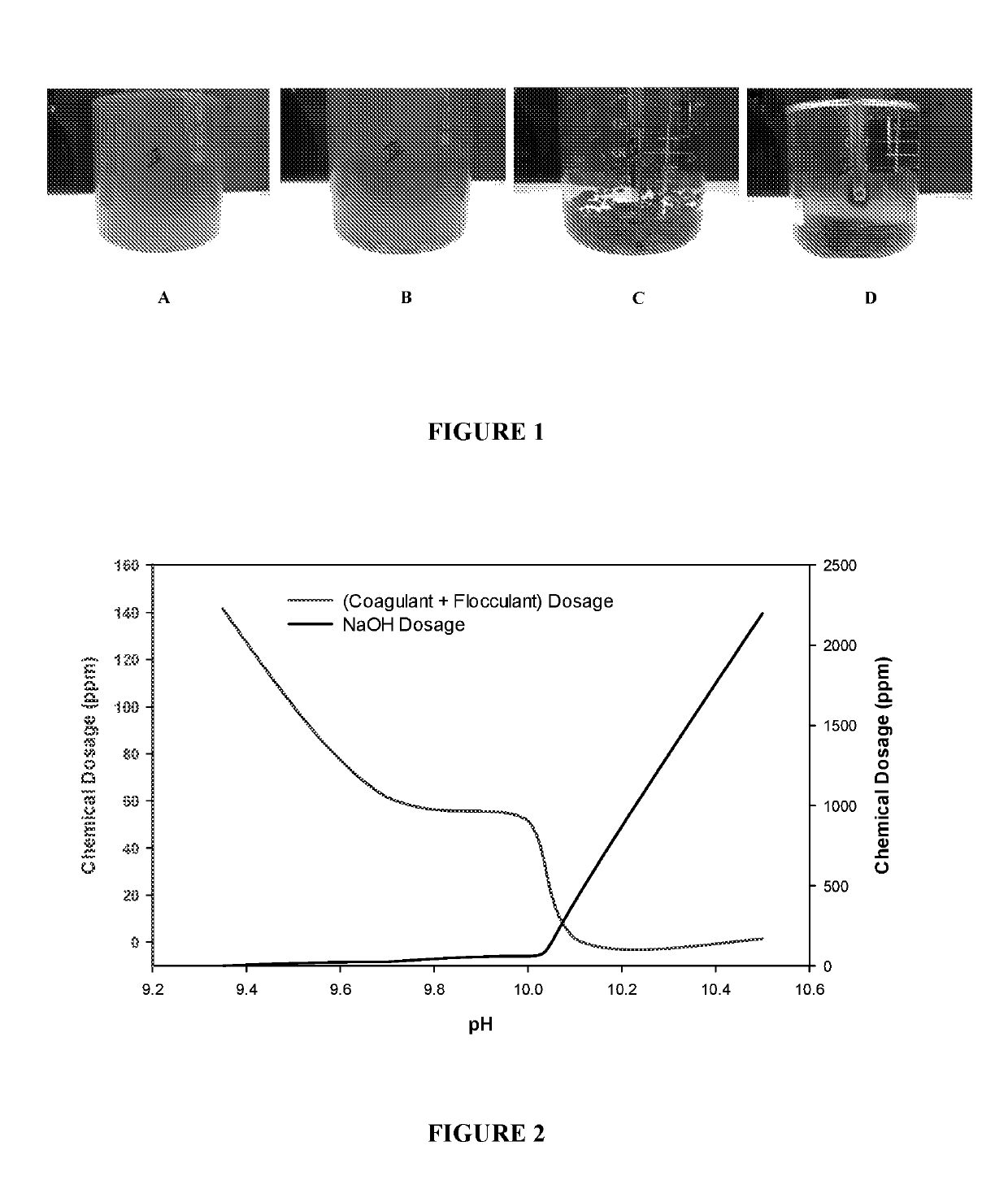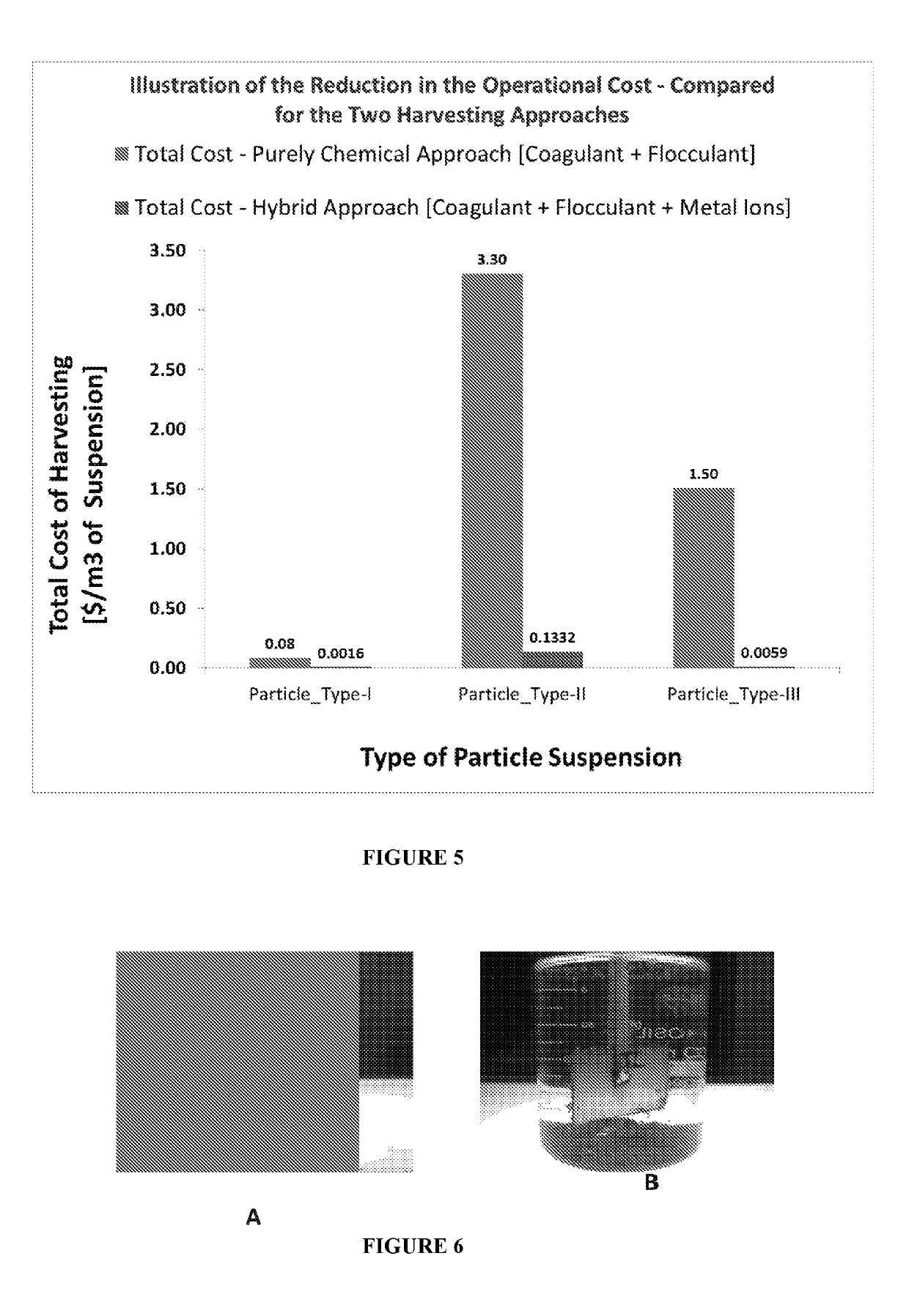Method for separating solid particles from a waterbody
a technology of solid particles and water bodies, applied in the direction of water treatment multi-stage treatment, separation processes, water treatment water, etc., can solve the problems of slow agitation of water bodies containing solid particles, considerable reduction of coagulation properties, and limitations of said methods
- Summary
- Abstract
- Description
- Claims
- Application Information
AI Technical Summary
Problems solved by technology
Method used
Image
Examples
example
Example-1: Demonstrates Reduction in Chemical Dosage by Unique Combination of Coagulant and Flocculant
[0177]A waterbody comprising solid particles such as microorganisms (e.g., an algal culture) is treated with the combinatorial dose of coagulant and flocculant as described in the instant disclosure for harvesting or separation of said microorganism from the waterbody and results in a reduced dosage of coagulant. Initially a cationic coagulant at a rate of about 5 ppm to 500 ppm for 500 ppm to 5000 ppm of microorganism in the waterbody, thereby destabilizing the microorganism suspension to form pin flocks by virtue of charge neutralization. Thereafter an anionic flocculant at a rate of about 0.5 ppm to 4.0 ppm for 500 ppm to 5000 ppm of microorganism is added to bind the microorganism pin flocks into large flocks.
[0178]A green algae from an outdoor open race way is harvested or separated from a waterbody, wherein coagulant dosage is reduced to about 150 ppm to 250 ppm upon combinato...
example 2
tes Reduction of Chemical Dosage During the Separation of Algae by Hybrid Electrocoagulation
[0180]A waterbody comprising filamentous BGA (Particle type-III) is treated with the hybrid electro-coagulation, wherein the electrical conduction is passed and it is observed that the coagulant dosage is reduced to about 1 ppm. Similarly, when a waterbody comprising green algae (Particle type-I) is subjected to electrical conduction above the electrode potential of the metal electrode, wherein the coagulant dosage is reduced to about 0.6 ppm.
[0181]Further, a waterbody comprising non-filamentous BGA (Particle type-II) is subjected to electrical conduction above the electrode potential of the metal electrode, wherein the coagulant dosage is reduced to about 100 ppm. In the above described 3 independent experiments the flocculant concentration ranges from about 0.5 ppm to 4.0 ppm for a algal suspension of 500 ppm to 5000 ppm.
example 3
tes the Reduction of Chemical Dosage During Separation of Algae by pH Modulated Coagulation-Flocculation
[0182]A waterbody comprising solid particles such as microorganisms (e.g. an algal culture) is treated with pH modulated coagulation-flocculation approach of the present disclosure, it is observed that the coagulant dosage is reduced to about 2 to 3 times when compared to only chemical coagulation-flocculation approach. It is observed that modulating pH of the waterbody by addition of NaOH and maintaining the pH towards alkalinity reduces the consumption of coagulant during separation or harvesting of microorganism (e.g. algal culture). The alkaline pH observed to reduce the coagulant consumption is in the range of about 8.5 to about 11. The observed pattern of chemical consumption during pH modulated coagulation-flocculation and only coagulation-flocculation approach and pH induced flocculation is exemplified in FIG. 2.
[0183]Upon subjecting a waterbody comprising virgin culture t...
PUM
| Property | Measurement | Unit |
|---|---|---|
| time | aaaaa | aaaaa |
| sedimentation time | aaaaa | aaaaa |
| cell densities | aaaaa | aaaaa |
Abstract
Description
Claims
Application Information
 Login to View More
Login to View More - R&D
- Intellectual Property
- Life Sciences
- Materials
- Tech Scout
- Unparalleled Data Quality
- Higher Quality Content
- 60% Fewer Hallucinations
Browse by: Latest US Patents, China's latest patents, Technical Efficacy Thesaurus, Application Domain, Technology Topic, Popular Technical Reports.
© 2025 PatSnap. All rights reserved.Legal|Privacy policy|Modern Slavery Act Transparency Statement|Sitemap|About US| Contact US: help@patsnap.com



